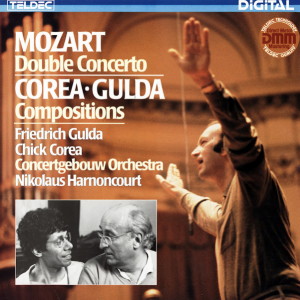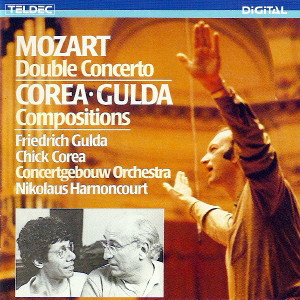 |
1 LP -
6.42961 AZ - (p) 1984
|
 |
| 1 CD -
8.42961 ZK - (p) 1984 |
|
| Wolfgang
Amadeus Mozart (1756-1791) |
|
|
|
Konzert für zwei Klaviere und
Orchester Nr. 10 Es-dur, KV 365 (316a)
|
|
25' 03" |
|
| - Allegro |
10' 15" |
|
A1 |
- Andante
|
8' 00" |
|
A2 |
| - Rondeaux: Allegro |
6' 48" |
|
A3 |
|
|
|
|
| Chick Corea (1941) |
|
|
|
| Fantasy
for two pianos |
|
11' 46" |
B1 |
|
|
|
|
| Friedrich Gulda
(1930-2000) |
|
|
|
| Ping Pong, for two
pianos |
|
9' 56" |
B2 |
|
|
|
|
| Friedrich
Gulda, Chick Corea, Klavier |
|
|
|
| CONCERTGEBOUW
ORCHESTRA, AMSTERDAM |
|
| Nikolaus
Harnoncourt, Dirigent |
|
|
Luogo
e data di registrazione
|
| Concertgebouw,
Amsterdam (Olanda) - 1983 |
|
Registrazione
live / studio
|
| studio |
Producer
/ Engineer
|
-
|
Prima Edizione CD
|
| Teldec
- 8.42961 ZK - (1 cd) - 47' 10" - (p)
1984 - DDD |
Prima
Edizione LP
|
Teldec - 6.42961
AZ - (1 lp) - 47'
10"
- (p) 1984 -
Digital
|
|
|
Notes
|
Friedrich Guida, Chick
Corea and Nikolaus Harnoncourt play
Mozart! The sensation that one was
prepared for, when word
ofthe project got around, turns into a
beauty that one takes for granted
after hearing the first bars. The
encounter is spectacular by all means,
but it is not a spectacle, and only
very hidebound or ill-informed
listeners will prejudge thc event from
on high, when these wanderers cross
boundaries and seek a new
homeland: global music.
The piano festival “Munich
Klaviersommer” of l982 saw the
initiation of a musical dialogue
between Gulda and Corea whose every
bar tells how productive creative
restlessness can make an “established”
musician who remains artistically
hungry. Both artists are driven by an
unwillingness to rest on their
laurels; Gulda has moved away from
concentrating exclusively
on classical music, while Corea has
been driven from modern jazz into
realms of Western classical tradition,
where the exact notes are prescribed
by the score. The third member of the
“alliance”, Nikolaus
Harnoncourt, is likewise a man of new
departures - he has been for
20 years now. However, the drastic yet
never exaggerated brushstroke with
which he is now sketching a new
picture of Mozart
may prove more disconcerting for some
listeners than his analytic
illumination of Baroque landscapes. In
Mozart’s world
Harnoncourt discovers clefts
and chasms, which he transforms into
his musical diction;
and he does this alongside Friedrich
Gulda and Chick Corea too, as
conductor of the Double Concerto.
The three artists - not forgetting
the Concertgebouw Orchestra of
Amsterdam - are unanimous in the
opinion that the concerto should not
be considered a “galant” trifle,
and rightly too. Mozart wrote the work
for himself and his
sister Nannerl in 1779, after his
return from the depressing Paris trip.
He must have thought highly of his
composition, otherwise he would not
have fetched it out
again later, in Vienna, for his
academy concerts. And he was certainly
seriously committed to the work -
otherwise, he would not have blended
all manner of
"darkenings of the horizon" (Einstein)
into the E flat major festive
splendour of the opening movement, he
would not have lent the andante a
colour of sonorous rapture with
divided violas. The solists seem to
share an affinity of
spirit, but at the same time to be
contrasting, figures. Guida makes a
lighter and more confident
impression, while Corea appears darker
and more questing, without lagging
behind technically as a result. The
way they play semiquaver triplets in
the slow movement, sometimes letting
them ripple from keyboard, sometimes
declaiming them, is
worth special investigation. The way
they inspire the outer movements with
charm sparkling wit is eiating
to hear.
Where eoncertante playing is "traced
back to its roots”, to dialogue and
spontaneous exchange of thought,
no-one will be surprised to hear both
conflict and harmony on the other side
of the record, in Gulda and
Corea`s unaccompanied piano duets. In
composing the tirst piece, Chick Corea
exploited the freedom to improvise offered
by a piece of this kind. Gulda
takes the first
jazz solo, Corea the second: the
artistic freedom is shared out with
precision. Chick Corea accounts for
the theme, while the epilogue is
played by Gulda.
“Ping-Pong”, the second piece on this
sidec, comes from Gulda`s pen, and
does honour to his name. Fast-reacting
virtuosi toss the ball to each other,
precious little seems pre-arranged.
Each of the two pianists pricks up hi
ears and reacts to what his partner
has just thrown into the conversation,
answering adagio deportment with a
smiling swing, cutting contemplation
short with impatience, following wide
stylistic and imaginative meanders
then coming to a halt, ending, with
violent clusters of notes.
Corea comes from the left,
Gulda from the right. One had a
foreboding of it with Mozart, but in
the duos, in which each player
speaks even more directly of himself, it becomes
certainly.
Wener
Burkhardt
Translation: Clive R. Williams
|
|
Nikolaus
Harnoncourt (1929-2016)
|

|

|
|